Maytag MLG20PRAWW, MLE20PDBYW, MLE20PRAYW, MLE20PRBYW, MLG20PDAWW Installation Instructions
...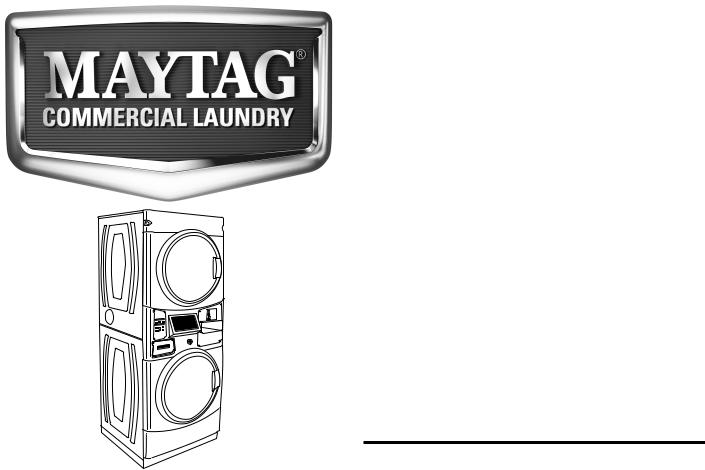
|
|
INSTALLATION |
|
|||
|
|
INSTRUCTIONS |
|
|||
|
|
Commercial Stacked Washer/Dryer |
||||
|
|
|
Gas or Electric |
|
|
|
|
|
INSTRUCTIONS |
|
|||
|
|
D’INSTALLATION |
||||
|
|
Laveuse/sécheuse superposées |
|
|||
|
|
|
à usage commercial |
|
|
|
|
|
|
À gaz ou électrique |
|
|
|
|
|
INSTRUCCIONES |
||||
|
|
DE INSTALACIÓN |
||||
|
|
Lavadora/Secadora comerciales |
||||
|
|
apiladas A gas o eléctricas |
|
|
||
TABLE OF CONTENTS |
|
TABLE DES MATIÈRES |
|
ÍNDICE |
|
|
. |
Page . |
Page |
. |
Página |
||
Stacked Washer/Dryer Safety.............. |
2 |
Sécurité de la laveuse/sécheuse |
|
Seguridad de la lavadora/ |
|
|
Tools & Parts ......................................... |
5 |
superposées........................................ |
40 |
secadora apiladas............................... |
|
80 |
Alternate Parts and Accessories......... |
6 |
Outils et pièces ................................... |
43 |
Herramientas y piezas........................ |
|
83 |
Dimensions/Clearances ...................... |
7 |
Pièces supplémentaires |
|
Piezas y accesorios adicionales ....... |
|
84 |
Stacked Washer/Gas Dryer |
|
et accessoires .................................... |
44 |
Dimensiones y espacios libres ......... |
|
85 |
Installation Requirements ................... |
8 |
Dimensions/Distances |
|
Requisitos de instalación de la |
|
|
Stacked Washer/Electric Dryer |
|
de dégagement .................................. |
45 |
lavadora/secadora a gas apiladas ... |
86 |
|
Installation Requirements ................. |
11 |
Exigences d’installation pour |
|
Requisitos de instalación de la |
|
|
Dryer Venting Requirements ............. |
15 |
la laveuse/sécheuse à gaz |
|
lavadora/secadora eléctricas |
|
|
Dryer Gas Supply Requirements ...... |
18 |
superposées........................................ |
46 |
apiladas ............................................... |
|
89 |
Installing Stacked Washer/Dryer....... |
19 |
Exigences d’installation pour la |
|
Requisitos de ventilación |
|
|
Washer Drain System ........................ |
22 |
laveuse/sécheuse électriques |
|
de la secadora .................................... |
|
94 |
Electric Dryer Electrical |
|
superposées ...................................... |
49 |
Requisitos del suministro |
|
|
Connections ....................................... |
23 |
Exigences concernant |
|
de gas de la secadora ....................... |
|
97 |
Leveling ................................................ |
27 |
l’évacuation de la sécheuse .............. |
54 |
Instalación de la lavadora/ |
|
|
Reversing Dryer Door Swing .............. |
29 |
Spécifications de l’alimentation |
|
secadora apiladas............................... |
|
98 |
Stacked Washer/Dryer |
|
en gaz de la sécheuse ....................... |
57 |
Sistema de desagüe |
|
|
Maintenance Instructions ................... |
31 |
Installation de la laveuse/sécheuse |
de la lavadora.................................... |
|
101 |
|
If You Need Assistance ....................... |
32 |
superposées ....................................... |
58 |
Conexiones eléctricas |
|
|
Electronic Control Setup |
|
Système d’évacuation |
|
de la secadora eléctrica .................. |
|
102 |
Instructions ......................................... |
33 |
de la laveuse........................................ |
61 |
Nivelación .......................................... |
|
106 |
Warranty .............................................. |
39 |
Raccordements de la sécheuse |
|
Cómo invertir el cierre |
|
|
|
|
électrique ............................................ |
62 |
de la puerta de la secadora .............. |
|
108 |
|
|
Nivellement .......................................... |
66 |
Instrucciones de mantenimiento |
|
|
|
|
Inversion du sens d’ouverture |
|
de la lavadora/secadora apiladas ... |
110 |
|
|
|
de la porte de la sécheuse ................. |
68 |
Si necesita ayuda .............................. |
|
111 |
|
|
Instructions d’entretien de la |
|
Instrucciones de programación |
|
|
|
|
laveuse/sécheuse superposées ....... |
70 |
del control electrónico ..................... |
|
112 |
|
|
Si vous avez besoin d’assistance ...... |
71 |
Garantía ............................................ |
|
120 |
|
|
Instructions de réglage du tableau |
|
|
|
|
|
|
de commande électronique .............. |
72 |
|
|
|
|
|
Garantie .............................................. |
79 |
|
|
|
W10045641B |
www.maytagcommerciallaundry.com |
|

STACKED WASHER/DRYER SAFETY
νIt is recommended that the owner post, in a prominent location, instructions for the customer’s use in the event the customer smells gas. This information should be obtained from your gas supplier.
νPost the following warning in a prominent location.
2
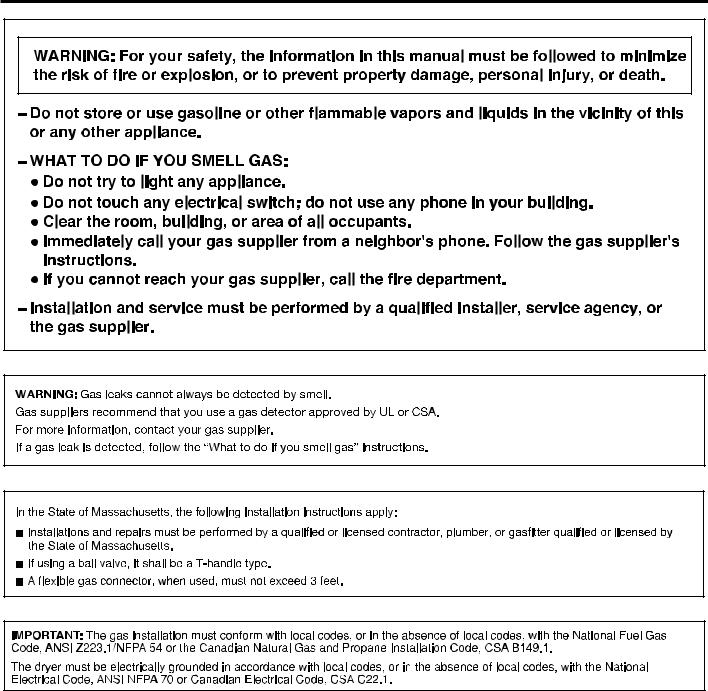
STACKED WASHER/DRYER SAFETY
3
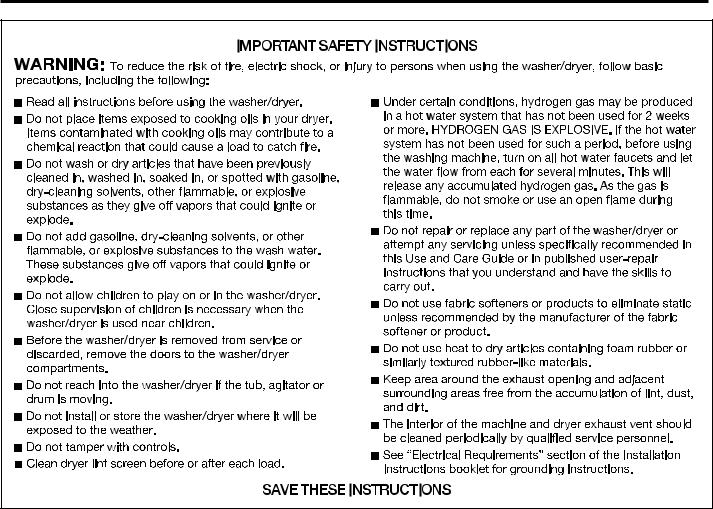
STACKED WASHER/DRYER SAFETY
4

TOOLS & PARTS
Tools Needed:
8" (203 mm) |
8" (203 mm) or 10" (254 mm) |
flat-blade screwdriver |
phillips screwdriver |
or 10" (254 mm) |
adjustable wrench |
|
|
pipe wrench |
that opens to 1" (25 mm) |
|
|
Torx®† T-20 security |
1" (25 mm) hex-head |
5⁄16" socket wrench |
pliers |
screwdriver or bit |
socket wrench |
|
(that open to 19/16" [39 mm]) |
level |
utility knife |
1/4" (6 mm) nut driver |
locking pliers |
caulk gun and caulk |
vent clamps |
pipe-joint compound |
27" (686 mm) wood block |
(for installing new exhaust vent) |
|
suitable for gas type |
|
flashlight (optional) |
1/2" (13 mm) and 9/16" |
ruler or measuring tape |
|
(14 mm) open-end wrenches |
|
Parts Supplied:
water inlet hoses (2) |
inlet hose washers (4) |
U-shaped hose form |
transit bolt hole plug (4) |
beaded tie strap
drain hose/clamp
†® TORX is a registered trademark of Saturn Fasteners, Inc.
5

ALTERNATE PARTS AND ACCESSORIES
Alternate Parts
Your installation may require additional parts. If you are interested in purchasing one of the items listed here, call the toll-free number in the “If You Need Assistance” section.
If You Have |
You Will Need to Buy |
|
|
Overhead sewer |
Standard 20 gal. (76 L) 39" |
|
(990 mm) tall drain tub or utility |
|
sink, sump pump and connectors |
|
(available from local plumbing |
|
suppliers) |
|
|
1" (25 mm) standpipe |
2" (51 mm) diameter to 1" (25 mm) |
|
diameter Standpipe Adapter |
|
Part Number 3363920 |
|
Connector Kit Part Number 285835 |
|
|
Drain hose too |
Extension Drain Hose Part |
short |
Number 285863 |
|
Connector Kit Part Number 285835 |
|
|
Lint clogged drain |
Drain Protector Part Number 367031 |
|
Connector Kit Part Number 285835 |
|
|
Floor drain system |
Siphon break, Part Number 285834 |
|
Connector Kit (x2) Part Number |
|
285835 |
|
Extension Drain Hose Part |
|
Number 285863 |
|
|
Water faucets |
2 longer water fill hoses: |
beyond reach |
6 ft. (1.8 m) 90° bend hose |
of fill hoses |
Part Number 76314 |
|
10 ft. (3.0 m) Part Number 350008 |
|
|
Accessories
Enhance your washer/dryer with these premium accessories.
For more high-quality items or to order, call 1-800-901-2042, or visit us at www.maytag.com/accessories.
In Canada call: 1-800-807-6777 or visit us at www.whirlpoolparts.ca.
Part Number |
Accessory |
|
|
8212526 |
Washer drip tray, fits under all |
|
|
31682 |
All-purpose appliance cleaner |
|
|
1903WH |
Laundry supply storage cart |
|
|
279818 |
3-way dryer venting kit |
|
|
285834 |
Siphon break kit |
|
|
6

DIMENSIONS/CLEARANCES
Dimensions
Front View |
|
Side View |
|
Back View |
|||||||||||||||||||
|
|
|
|
|
27" |
|
|
|
|
|
|
51" |
|
|
|
|
|
|
|
|
|||
|
|
|
|
|
|
|
|
|
|
|
|
||||||||||||
|
|
|
|
|
(686 mm) |
|
|
|
(1295 mm) |
|
|
|
|
|
|
||||||||
|
|
|
|
|
|
|
|
|
|
|
|
|
|
|
|
|
|
|
|
|
|
|
|
|
|
|
|
|
|
|
|
|
|
|
|
|
|
|
|
|
|
|
|
|
|
|
|
|
|
|
|
|
|
|
|
|
|
|
|
|
|
|
|
|
|
|
|
|
|
|
|
|
|
|
|
|
|
|
|
|
|
|
|
|
|
|
|
|
|
|
|
|
|
|
|
|
|
|
|
|
|
|
|
|
|
|
|
|
|
|
|
|
|
|
|
|
|
|
|
|
|
|
|
|
|
|
|
|
|
|
|
|
|
|
|
|
|
|
|
|
|
|
|
|
|
|
|
|
|
|
|
|
|
|
|
|
|
|
|
|
|
|
|
|
|
|
|
|
|
|
|
|
|
|
|
|
|
|
|
|
|
|
|
|
|
|
|
|
|
|
|
74" |
74" |
|
(1880 mm) |
||
(1880 mm) |
||
|
|
|
|
|
|
|
|
|
|
|
|
|
|
|
|
|
|
|
|
|
|
|
|
|
|
|
|
|
|
|
|
|
|
|
|
|
|
|
|
|
|
|
|
|
|
|
|
|
|
|
|
|
|
|
|
|
|
|
|
|
|
|
|
|
|
|
|
|
|
|
|
|
|
|
|
|
|
|
|
|
|
|
|
|
|
|
|
|
|
|
|
|
|
|
|
|
|
|
|
|
|
|
|
|
|
|
|
|
|
|
|
|
|
|
|
|
|
|
|
|
|
|
|
|
|
|
|
|
|
|
|
|
|
|
|
|
|
|
|
|
|
|
|
|
|
|
|
|
|
|
|
|
|
|
|
|
|
|
|
|
|
|
|
|
|
|
|
|
|
|
|
|
|
|
|
|
|
|
|
|
|
|
|
|
|
|
|
|
|
|
|
|
|
|
|
|
|
|
|
|
|
|
|
|
|
|
|
|
|
|
|
|
|
|
|
|
|
|
|
|
|
|
|
|
|
|
|
|
|
|
|
|
|
|
|
|
|
|
|
|
|
|
|
|
|
|
|
|
|
|
|
|
|
|
|
|
|
|
|
|
|
|
|
|
|
|
|
|
|
|
|
|
|
|
|
|
|
|
|
|
|
|
|
|
|
|
|
|
|
|
|
|
|
|
|
|
|
|
|
|
|
|
|
|
|
|
|
|
|
|
|
|
|
|
|
|
|
|
|
|
|
|
|
|
|
|
|
|
|
|
|
|
|
|
|
|
|
|
|
|
|
|
|
|
|
|
|
|
|
|
|
|
|
|
|
|
|
|
|
|
|
|
|
|
|
|
|
|
|
|
|
|
|
|
|
|
|
|
|
|
|
|
|
|
|
|
|
|
|
|
|
|
|
|
|
|
|
|
|
|
|
|
|
|
|
|
|
|
|
|
|
|
|
|
|
|
|
|
|
|
|
|
|
|
|
|
|
|
|
|
|
|
|
|
|
|
|
|
|
|
|
|
|
|
|
|
29 1/2" |
|
|
|
|
|
|
|
|
|
|
|
|
|
|
|
|
|
|
|
||
|
|
|
|
|
|
|
|
|
|
|
|
|
|
|
|
|
|
|
|
|
|
|
|
|
|
|
|
|
|
|
|
||||
1" |
|
|
|
|
|
|
|
|
|
|
|
|
|
|
|
|
|
|
|
|
|
|
|
|
|
|
|
|
|
|
|
|
|
||
|
|
|
(751 mm) |
|
|
1" |
|
|
|
|
|
|
|
|
|
|
|
|
|
|
|
||||||||||||||
(25 mm) |
|
|
|
|
|
|
|
|
|
|
|
|
|
|
|
|
|
|
|
||||||||||||||||
|
|
|
|
|
|
|
|
(25 mm) |
|
|
|
|
|
|
|
||||||||||||||||||||
|
|
|
|
|
|
|
|
|
|
|
|
|
|
|
|
|
|
|
|
|
|
|
|
|
|
||||||||||
Clearances
Side Clearances Back/Top Clearances
|
|
|
|
|
|
|
|
|
|
|
|
|
|
|
|
|
|
|
|
|
|
|
|
|
|
|
|
|
|
|
|
|
|
|
|
|
|
|
|
|
|
|
|
|
|
|
|
|
|
|
|
|
|
|
|
|
|
|
|
|
|
|
|
|
|
|
|
|
|
|
|
|
|
|
|
|
|
|
|
|
|
|
|
|
|
|
|
|
|
|
|
|
|
|
|
|
|
|
|
|
|
|
|
|
|
|
|
|
|
|
|
|
|
|
|
|
|
|
|
|
|
|
|
|
|
|
|
|
|
|
|
|
|
|
|
|
|
|
|
|
|
|
|
|
|
|
|
|
|
|
|
|
|
|
|
|
|
|
|
|
|
|
|
|
|
|
|
|
|
|
|
|
|
|
|
|
|
|
|
|
|
|
|
|
|
|
|
|
|
|
|
|
|
|
|
|
|
|
|
|
|
|
|
|
|
|
|
|
|
|
|
|
|
|
|
|
|
|
|
|
|
|
|
|
|
|
|
|
|
|
|
|
|
|
|
|
|
|
|
|
|
|
|
|
|
|
|
|
|
|
|
|
|
|
|
|
|
|
|
|
|
|
|
|
|
|
|
|
|
|
|
|
|
|
|
|
|
|
|
|
|
|
|
|
|
|
|
|
|
|
|
|
|
|
|
|
|
|
|
|
|
|
|
|
|
|
|
|
|
|
|
|
|
|
|
|
|
|
|
|
|
|
|
|
|
|
|
|
|
|
|
|
|
|
|
|
|
|
|
|
|
|
|
|
|
|
|
|
|
|
|
|
|
|
|
|
|
|
|
|
|
|
|
|
|
|
|
|
|
|
|
|
|
|
|
|
|
|
|
|
|
|
|
|
|
|
|
|
|
|
|
|
|
|
|
|
|
|
|
|
|
|
|
|
|
|
|
|
|
|
|
|
|
|
|
|
|
|
|
|
|
|
|
|
|
|
|
|
|
|
|
|
|
|
|
|
|
|
|
|
|
|
|
|
|
|
|
|
|
|
|
|
|
|
|
|
|
|
|
|
|
|
|
|
|
|
|
|
|
|
|
|
|
|
|
|
|
|
|
|
|
|
|
|
|
|
|
|
|
|
|
|
|
|
|
|
|
|
|
|
|
|
|
0" |
|
|
|
|
|
|
|
|
0" |
|
|
|
|
|
|
|
|
|
|
|
|
|
|
|
|
|
|
|
|
|
|
|
|
|
|
|
|||||
|
|
|
|
|
|
|
|
|
|
|
|
|
|
|
|
|
|
|
|
|
|
|
|
|
|
|
|
|
|
|
|
|
|
|
|||||||
|
|
|
|
(0 mm) |
|
|
(0 mm) |
|
|
|
|
|
|
|
|
|
|
|
|
|
|
|
|
|
|
|
|
|
|
|
|
||||||||||
|
|
|
|
|
|
|
|
|
|
|
|
|
|
|
|
|
|
|
|
|
|
|
|
|
|
|
|
|
|
|
|
||||||||||
7

STACKED WASHER/GAS DRYER INSTALLATION REQUIREMENTS
Stacked Washer/Gas Dryer Location
Selecting the proper location for your washer/dryer improves performance and minimizes noise and possible washer “walk.”
Your washer/dryer can be installed in a basement, laundry room, or recessed area. See “Drain System.”
Companion appliance location requirements should also be considered.
IMPORTANT: Do not install or store the washer/dryer where it will be exposed to the weather. Do not store or operate the washer/dryer in temperatures at or below 32°F (0°C). Some water can remain in the washer and can cause damage in low temperatures. Proper installation is your responsibility.
You will need:
νA water heater set to deliver 120°F (49°C) water to the washer.
νA grounded electrical outlet located within 6 ft. (1.8 m) of where the power cord is attached to the back of the washer. See “Electrical Requirements.”
νHot and cold water faucets located within 4 ft. (1.2 m) of the hot and cold water fill valves, and water pressure of 20–100 psi (137.9–689.6 kPa).
νA level floor with a maximum slope of 1" (25 mm) under entire washer/dryer. Installing the washer/dryer on soft floor surfaces, such as carpets or surfaces with foam backing, is not recommended.
νA sturdy and solid floor to support the washer/dryer with a total weight (water and load) of 450 lbs (204 kg).
νA floor drain under the bulkhead. Prefabricated bulkheads with electrical outlets, water inlet lines, and drain facilities should be used only where local codes permit.
Stacked washer/gas dryer installation clearances
νThe location must be large enough to allow the washer and dryer doors to be fully opened.
νAdditional spacing should be considered for ease of installation and servicing. The doors open more than 180°. The washer door is not revers ble.
νAdditional clearances might be required for wall, door, and floor moldings.
νAdditional spacing of 1" (25 mm) on all sides of the washer/ dryer is recommended to reduce noise transfer.
νCompanion appliance spacing should also be considered.
When installing a gas dryer:
IMPORTANT: Observe all governing codes and ordinances.
νCheck code requirements: Some codes limit or do not permit installation of clothes dryers in garages, closets,
or sleeping quarters. Contact your local building inspector.
νMake sure that lower edges of the cabinet, plus the back and bottom sides of the washer, are free of obstructions to permit adequate clearance of air openings for combustion air. See “Recessed Area Installation Instructions” below for minimum spacing requirements.
Recessed Area Installation Instructions
This washer/dryer may be installed in a recessed area. For recessed area installations, minimum clearances can be found on the warning label on the rear of the dryer or in “Dimensions/ Clearances.”
The installation spacing is in inches and is the minimum allowable. Additional spacing should be considered for ease of installation, servicing, and compliance with local codes and ordinances.
The dryer must be exhausted outdoors.
8
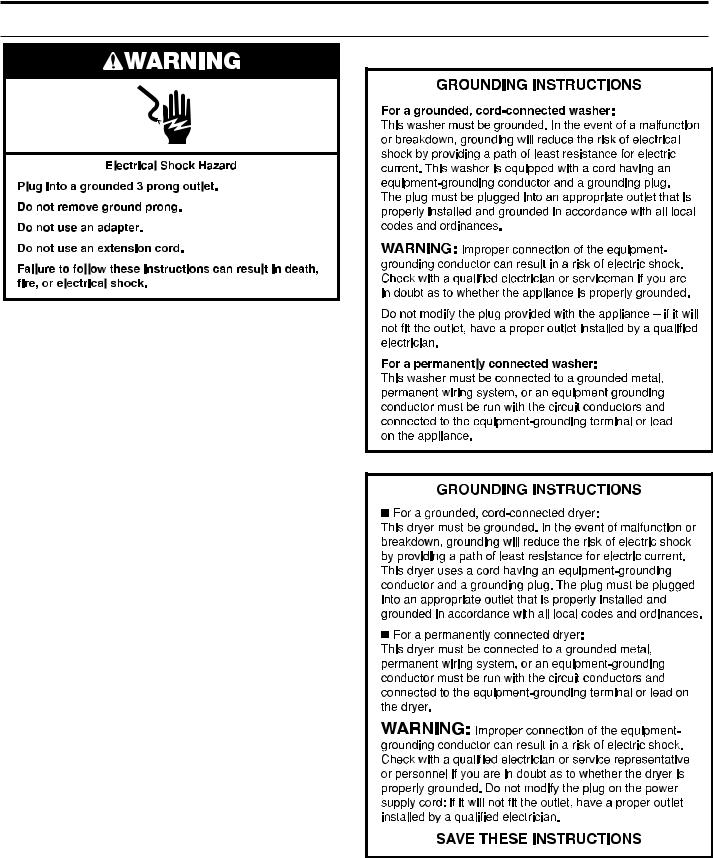
STACKED WASHER/GAS DRYER INSTALLATION REQUIREMENTS
Stacked Washer/Gas Dryer Electrical Requirements
Stacked Washer/Gas Dryer Grounding
IMPORTANT: The washer/dryer must be electrically grounded in accordance with local codes and ordinances or, in the absence of local codes, with the National Electrical Code, ANSI/NFPA 70, latest edition, or Canadian Electrical Code, CSA C22.1. If codes permit and a separate ground wire is used, it is recommended that a qualified electrical installer determine
that the ground path is adequate.
A copy of the above code standards can be obtained from:
National Fire Protection Association
One Batterymarch Park, Quincy, MA 02269
CSA International
8501 East Pleasant Valley Road
Cleveland, Ohio 44131-5575 ν Do not ground to a gas pipe.
ν Do not have a fuse in the neutral or ground circuit.
ν A 120 volt, 60 Hz, AC only, 15or 20-amp, fused electrical circuit is required. A time-delay fuse or circuit breaker is also recommended. It is recommended that a separate circuit serving only this washer/dryer be provided.
ν This washer/dryer is equipped with a power supply cord having a 3-prong grounding plug.
ν To minimize the possibility of shock, the cord must be plugged into a mating, 3 prong, grounding-type outlet, grounded in accordance with local codes and ordinances. If a mating outlet is not available, it is the personal responsibility and obligation of the customer to have the properly grounded outlet installed by a qualified electrician.
νIf codes permit and a separate ground wire is used, it is recommended that a qualified electrician determine that the
ground path is adequate.
ν Check with a qualified electrician if you are not sure the washer/dryer is properly grounded.
9

STACKED WASHER/GAS DRYER INSTALLATION REQUIREMENTS
Stacked Washer/Gas Dryer Gas Supply
IMPORTANT: Observe all governing codes and ordinances.
This installation must conform with all local codes and ordinances. In the absence of local codes, installation must conform with American National Standard, National Fuel Gas Code ANSI Z223.1/NFPA 54 or CAN/CSA B149.
A copy of the above code standards can be obtained from:
National Fire Protection Association
One Batterymarch Park, Quincy, MA 02269
CSA International
8501 East Pleasant Valley Road
Cleveland, Ohio 44131-5575
The design of this washer/dryer has been certified by CSA International for use at altitudes up to 10,000 feet (3048 m) above sea level at the B.T.U. rating indicated on the model/ serial plate. Burner input adjustments are not required when the washer/dryer is operated up to this elevation.
When installed above 10,000 feet (3048 m), a four percent (4%) reduction of the burner B.T.U. rating shown on the model/ serial plate is required for each 1,000 foot (305 m) increase in elevation. For assistance when converting to other gas types and/or installing above 10,000 feet (3048 m) elevation, contact your local service company.
10

STACKED WASHER/ELECTRIC DRYER INSTALLATION REQUIREMENTS
Stacked Washer/Electric Dryer Location
Selecting the proper location for your washer/dryer improves performance and minimizes noise and possible washer “walk.”
Your washer/dryer can be installed in a basement, laundry room, or recessed area. See “Drain System.”
Companion appliance location requirements should also be considered.
IMPORTANT: Do not install or store the washer/dryer where it will be exposed to the weather. Do not store or operate the washer/dryer in temperatures at or below 32°F (0°C). Some water can remain in the washer and can cause damage in low temperatures. Proper installation is your responsibility.
You will need:
νA water heater set to deliver 120°F (49°C) water to the washer.
νA grounded electrical outlet located within 6 ft. (1.8 m) of where the power cord is attached to the back of the washer. See “Electrical Requirements.”
νHot and cold water faucets located within 4 ft. (1.2 m) of the hot and cold water fill valves, and water pressure of 20–100 psi (137.9–689.6 kPa).
νA level floor with a maximum slope of 1" (25 mm) under entire washer/dryer. Installing the washer/dryer on soft floor surfaces, such as carpets or surfaces with foam backing, is not recommended.
νA sturdy and solid floor to support the washer/dryer with a total weight (water and load) of 450 lbs (204 kg).
νA floor drain under the bulkhead. Prefabricated bulkheads with electrical outlets, water inlet lines, and drain facilities should be used only where local codes permit.
Stacked washer/electric dryer installation clearances
νThe location must be large enough to allow the washer and dryer doors to be fully opened.
νAdditional spacing should be considered for ease of installation and servicing. The doors open more than 180°. The washer door is not reversible.
νAdditional clearances might be required for wall, door, and floor moldings.
νAdditional spacing of 1" (25 mm) on all sides of the washer/ dryer is recommended to reduce noise transfer.
νCompanion appliance spacing should also be considered.
Recessed Area Installation Instructions
This washer/dryer may be installed in a recessed area. For recessed area installations, minimum clearances can be found on the warning label on the rear of the dryer.
The installation spacing is in inches and is the minimum allowable. Additional spacing should be considered for ease of installation, servicing, and compliance with local codes and ordinances.
The dryer must be exhausted outdoors.
11
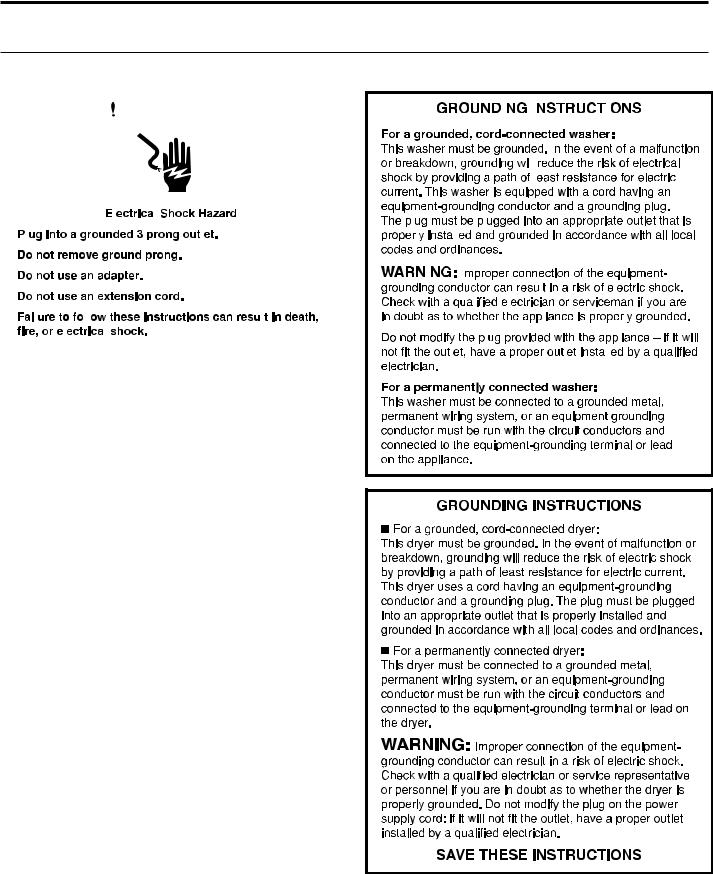
STACKED WASHER/ELECTRIC DRYER INSTALLATION REQUIREMENTS
Stacked Washer/Electric Dryer Electrical
Requirements
Washer Electrical Requirements |
Stacked Washer/Electric Dryer Grounding |
|||||||||||||||||||||||||||||||
|
|
|
|
|
|
|
|
|
|
|
|
|
|
|
|
|
|
|
|
|
|
|
|
|
|
|
|
|
|
|
|
|
|
|
|
|
|
|
|
|
|
|
|
|
|
|
|
|
|
|
|
|
|
|
|
|
|
|
|
|
|
|
|
|
|
|
|
|
|
|
|
|
|
|
|
|
|
|
|
|
|
|
|
|
|
|
|
|
|
|
|
|
|
|
|
|
|
|
|
|
|
|
|
|
|
|
|
|
|
|
|
|
|
|
|
|
|
|
|
|
|
|
|
|
|
|
|
|
|
|
|
|
|
|
|
|
|
|
|
|
|
|
|
|
|
|
|
|
|
|
|
|
|
|
|
|
|
|
|
|
|
|
|
|
|
|
|
|
|
|
|
|
|
|
|
|
|
|
|
|
|
|
|
|
|
|
|
|
|
|
|
|
|
|
|
|
|
|
|
|
|
|
|
|
|
|
|
|
|
|
|
|
|
|
|
|
|
|
|
|
|
|
|
|
|
|
|
|
|
|
|
|
|
|
|
|
|
|
|
|
|
|
|
|
|
|
|
|
|
|
|
|
|
|
|
|
|
|
|
|
|
|
|
|
|
|
|
|
|
|
|
|
|
|
|
|
|
|
|
|
|
|
|
|
|
|
|
|
|
|
|
|
|
|
|
|
|
|
|
|
|
|
|
|
|
|
|
|
|
|
|
|
|
|
|
|
|
|
|
|
|
|
|
|
|
|
|
|
|
|
|
|
|
|
|
|
|
|
|
|
|
|
|
|
|
|
|
|
|
|
|
|
|
|
|
|
|
|
|
|
|
|
|
|
|
|
|
|
|
|
|
|
|
|
|
|
|
|
|
|
|
|
|
|
|
|
|
|
|
|
|
|
|
|
|
|
|
|
|
|
|
|
|
|
|
|
|
|
|
|
|
|
|
|
|
|
|
|
|
|
|
|
|
|
|
|
|
|
|
|
|
|
|
|
|
|
|
|
|
|
|
|
|
|
|
|
|
|
|
|
|
|
|
|
|
|
|
|
|
|
|
|
|
|
|
|
|
|
|
|
|
|
|
|
|
|
|
|
|
|
|
|
|
|
|
|
|
|
|
|
|
|
|
|
|
|
|
|
|
|
|
|
|
|
|
|
|
|
|
|
|
|
|
|
|
|
|
|
|
|
|
|
|
|
|
|
|
|
|
|
|
|
|
|
|
|
|
|
|
|
|
|
|
|
|
|
|
|
|
|
|
|
|
|
|
|
|
|
|
|
|
|
|
|
|
|
|
|
|
|
|
|
|
|
|
|
|
|
|
|
|
|
|
|
|
|
|
|
|
|
|
|
|
|
|
|
|
|
|
|
|
|
|
|
|
|
|
|
|
|
|
|
|
|
|
|
|
|
|
|
|
|
|
|
|
|
|
|
|
|
|
|
|
|
|
|
|
|
|
|
|
|
|
|
|
|
|
|
|
|
|
|
|
|
|
|
|
|
|
|
|
|
|
|
|
|
|
|
|
|
|
|
|
|
|
|
|
|
|
|
|
|
|
|
|
|
|
|
|
|
|
|
|
|
|
|
|
|
|
|
|
|
|
|
|
|
|
|
|
|
|
|
|
|
|
|
|
|
|
|
|
|
|
|
|
|
|
|
|
|
|
|
|
|
|
|
|
|
|
|
|
|
|
|
|
|
|
|
|
|
|
|
|
|
|
|
|
|
|
|
|
|
|
|
|
|
|
|
|
|
|
|
|
|
|
|
|
|
|
|
|
|
|
|
|
|
|
|
|
|
|
|
|
|
|
|
|
|
|
|
|
|
|
|
|
|
|
|
|
|
|
|
|
|
|
|
|
|
|
|
|
|
|
|
|
|
|
|
|
|
|
|
|
|
|
|
|
|
|
|
|
|
|
|
|
|
|
|
|
|
|
|
|
|
|
|
|
|
|
|
|
|
|
|
|
|
|
|
|
|
|
|
|
|
|
|
|
|
|
|
|
|
|
|
|
|
|
|
|
|
|
|
|
|
|
|
|
|
|
|
|
|
|
|
|
|
|
|
|
|
|
|
|
|
|
|
|
|
|
|
|
|
|
|
|
|
|
|
|
|
|
|
|
|
|
|
|
|
|
|
|
|
|
|
|
|
|
|
|
|
|
|
|
|
|
|
|
|
|
|
|
|
|
|
|
|
|
|
|
|
|
|
|
|
|
|
|
|
|
|
|
|
|
|
|
|
|
|
|
|
|
|
|
|
|
|
|
|
|
|
|
|
|
|
|
|
|
|
|
|
|
|
|
|
|
|
|
|
|
|
|
|
ν Do not have a fuse in the neutral or ground circuit.
νThis washer/dryer is equipped with a power supply cord having a 3 prong grounding plug.
νTo minimize the possibility of shock, the cord must be
plugged into a mating, 3 prong, grounding-type outlet, grounded in accordance with local codes and ordinances. If a mating outlet is not available, it is the personal responsibility and obligation of the customer to have the properly grounded outlet installed by a qualified electrician.
νIf codes permit and a separate ground wire is used, it is recommended that a qualified electrician determine that
the ground path is adequate.
ν Check with a qualified electrician if you are not sure the washer is properly grounded.
12

STACKED WASHER/ELECTRIC DRYER INSTALLATION REQUIREMENTS
Dryer Electrical Requirements
It is your responsibility:
νTo contact a qualified electrical installer.
νTo be sure that the electrical connection is adequate and in conformance with the National Electrical Code, ANSI/NFPA 70-latest edition and all local codes and ordinances.
The National Electrical Code requires a 4-wire power supply connection for homes built after 1996 and dryer circuits involved in remodeling after 1996.
A copy of the above code standards can be obtained from: National Fire Protection Association, One Batterymarch Park, Quincy, MA 02269.
νTo supply the required 3 or 4 wire, single phase, 240 volt, 60 Hz., AC only electrical supply (or 3 or 4 wire, 120/208 volt electrical supply, if specified on the serial/rating plate) on a separate 30-amp circuit, fused on both sides of the line. A time delay fuse or circuit breaker is recommended. Connect to an individual branch circuit. Do not have a fuse in the neutral or grounding circuit.
νDo not use an extension cord.
νIf codes permit and a separate ground wire is used, it is recommended that a qualified electrician determine that the ground path is adequate.
Electrical Connection
To properly install your dryer, you must determine the type of electrical connection you will be using and follow the instructions provided for it here.
νThis dryer is manufactured ready to install with a 3-wire electrical supply connection. The neutral ground conductor is permanently connected to the neutral conductor (white wire) within the dryer. If the dryer is installed with a 4-wire electrical supply connection, the neutral ground conductor must be removed from the external ground connector (green screw), and secured under the neutral terminal (center or white wire) of the terminal block. When the neutral ground conductor is secured under the neutral terminal (center
or white wire) of the terminal block, the dryer cabinet is isolated from the neutral conductor.
νIf local codes do not permit the connection of a neutral ground wire to the neutral wire, see “Optional 3-wire connection” section.
νA 4-wire power supply connection must be
used when the appliance is installed in a location where grounding through the neutral conductor is prohibited. Grounding through the neutral is prohibited for (1) new branch-circuit installations, (2) recreational vehicles, and
(3) areas where local codes prohibit grounding through the
neutral conductor.
Electric Dryer Power Supply Cord
If using a power supply cord:
Use a UL listed power supply cord kit marked for use with clothes dryers. The kit should contain:
νA UL listed 30-amp power supply cord, rated 240 volt minimum. The cord should be type SRD or SRDT and be at least 4 ft. (1.22 m) long. The wires that connect to the dryer must end in ring terminals or “U” shaped spade terminals with upturned ends.
νA UL listed strain relief.
If your outlet looks like this:
4-wire receptacle (14-30R)
Then choose a 4-wire power supply cord with ring or spade terminals and UL listed strain relief. The 4-wire power supply cord, at least 4 ft. (1.22 m) long, must have four 10-gauge copper wires and match a 4-wire receptacle of NEMA Type 14-30R. The ground wire (ground conductor) may be either green or bare. The neutral conductor must be identified by a white cover.
If your outlet looks like this:
Then choose a 3-wire power supply cord with ring or spade terminals and UL listed strain relief. The 3-wire power supply cord, at least 4 ft. (1.22 m) long, must have three 10-gauge copper wires and match a 3-wire receptacle of NEMA Type 10-30R.
3-wire receptacle (10-30R)
13
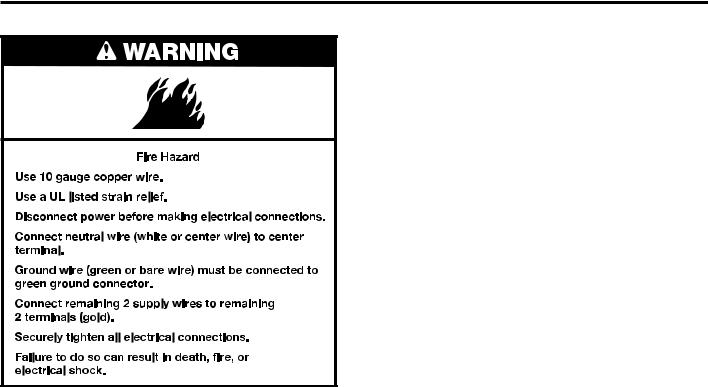
STACKED WASHER/ELECTRIC DRYER INSTALLATION REQUIREMENTS
Dryer Direct Wire
If connecting by direct wire:
Power supply cable must match power supply (4-wire or 3-wire) and be:
νFlexible armored cable or nonmetallic sheathed copper cable (with ground wire), covered with flexible metallic conduit. All current-carrying wires must be insulated.
ν10-gauge solid copper wire (do not use aluminum).
νAt least 5 ft. (1.52 m) long.
14
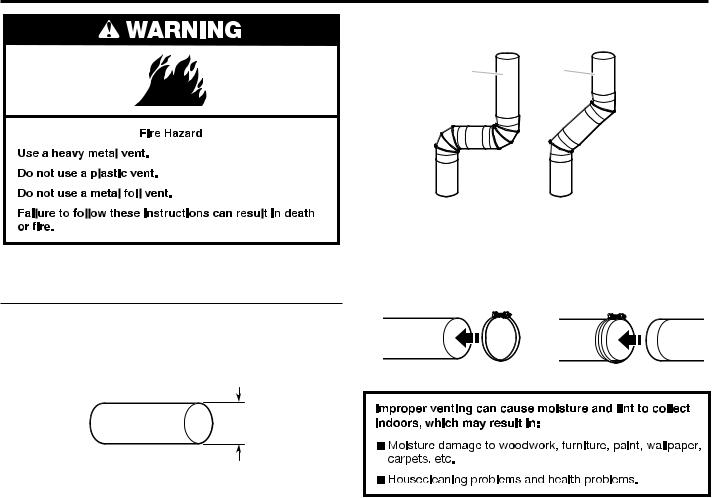
DRYER VENTING REQUIREMENTS
WARNING: To reduce the risk of fire, this dryer MUST BE EXHAUSTED OUTDOORS.
IMPORTANT: Observe all governing codes and ordinances.
Dryer exhaust must not be connected into any gas vent, chimney, wall, ceiling, attic, crawlspace, or a concealed space of a building. Only rigid or flexible metal vent shall be used for exhausting.
Elbows:
■■ 45° elbows provide better airflow than 90° elbows.
Good |
Better |
Clamps:
■■ Use clamps to seal all joints.
■■ Exhaust vent must not be connected or secured with screws or other fastening devices that extend into interior
of duct and catch lint. Do not use duct tape.
4" (102 mm)
4" (102 mm) heavy, metal exhaust vent
■■ Only a 4" (102 mm) heavy, metal exhaust vent and clamps may be used.
■■ Do not use plastic or metal foil vent.
Rigid metal vent:
■■ Recommended for best drying performance and to avoid crushing and kinking.
Flexible metal vent: (Acceptable only if accessible to clean)
■■ Must be fully extended and supported in final dryer location.
■■ Remove excess to avoid sagging and kinking that may result in reduced airflow and poor performance.
■■ Do not install in enclosed walls, ceilings, or floors. ■■ The total length should not exceed 73⁄4 ft. (2.4 m).
NOTE: If using an existing vent system, clean lint from entire length of the system and make sure exhaust hood is not plugged with lint. Replace plastic or metal foil vents with rigid metal or flexible metal vents. Review “Vent System Chart” and if necessary, modify existing vent system to achieve best drying performance.
15
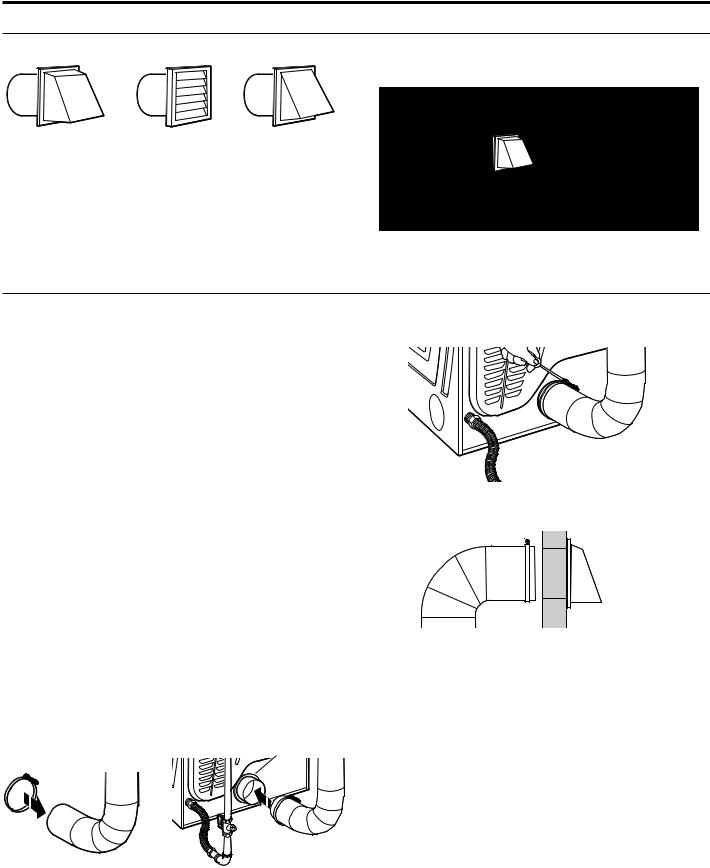
DRYER VENTING REQUIREMENTS
Vent Hoods
4" (102 mm) Diameter Exhaust Hoods |
Exhaust hood must be at least 12" (305 mm) from the ground |
|
or any object that may be in the path of the exhaust (such as |
|
flowers, rocks, bushes, or snow). |
box hood |
louvered hood |
angled hood |
12" min.
 (305 mm)
(305 mm)
Vent System Length
Maximum Vent Length/Vent Connection
Maximum length of vent system depends upon the type of vent used, number of elbows, and type of exhaust hood.
Vent System Chart (Rigid Metal Vent)
No. of |
Box and |
Angled |
90˚ Turns |
Louvered Hood |
Hood |
0 |
135 ft. (41.2 m) |
129 ft. (39.3 m) |
1 |
125 ft. (38.1 m) |
119 ft. (36.3 m) |
2 |
115 ft. (35.1 m) |
109 ft. (33.2 m) |
3 |
106 ft. (32.3 m) |
100 ft. (30.5 m) |
4 |
98 ft. (29.9 m) |
92 ft. (28.0 m) |
For vent systems not covered by the vent specification chart, see your parts distributor.
Provision must be made for enough air for combustion and ventilation. (Check governing codes and ordinances.) See “Recessed Area Installation Instructions” in the “Stacked Washer/Gas Dryer Location” and “Stacked Washer/Electric Dryer Location” sections.
A 4" (102 mm) outlet hood is preferred. However, a 21⁄2" (64 mm) outlet exhaust hood may be used. A 21⁄2" (64 mm) outlet creates greater back pressure than other hood types.
For permanent installation, a stationary vent system is required.
Connect Vent
1.If connecting to existing vent, make sure the vent is clean.
2.Using a 4" (102 mm) clamp, connect vent to exhaust outlet
in dryer.
3. Tighten hose clamp with Phillips screwdriver.
4.Make sure the vent is secured to exhaust hood with a 4" (102 mm) clamp.
5.Move dryer into final position. Do not crush or kink vent. Make sure dryer is level.
NOTE: Do not remove vent collar.
16

DRYER VENTING REQUIREMENTS
If an Exhaust Hood Cannot be Used
The outside end of main vent should have a sweep elbow directed downward.
12" min. 24" min.
(305 mm)* (610 mm)
*Minimum clearance above any accumulation of snow, ice, or debris such as leaves
If main vent travels vertically through the roof, rather than through wall, install a 180° sweep elbow on end of vent at least 2 ft. (610 mm) above surface of roof.
The opening in wall or roof shall have a diameter 1⁄2" (13 mm) larger than vent diameter. Vent should be centered in opening.
Do not install screening over end of vent for best performance.
Multiple Dryer Venting
A main vent can be used for venting a group of dryers. The main vent should be sized to remove 200 CFM of air per dryer. Large-capacity lint screens of proper design may be used in main vent if checked and cleaned frequently. The room where the dryers are located should have make-up air equal to or greater than CFM of all the dryers in the room.
Back-draft Damper Kit, Part No. 3391910, is available from your distributor and should be installed in the vent of each dryer to keep exhausted air from returning into dryers and to keep exhaust in balance within main vent. Unobstructed return air openings are required.
Each vent should enter the main vent at an angle pointing in the direction of the airflow. Vents entering from the opposite side should be staggered to reduce the exhausted air from interfering with the other vents.
 air ow
air ow
The maximum angle of each vent entering the main vent should be no more than 30°.
17
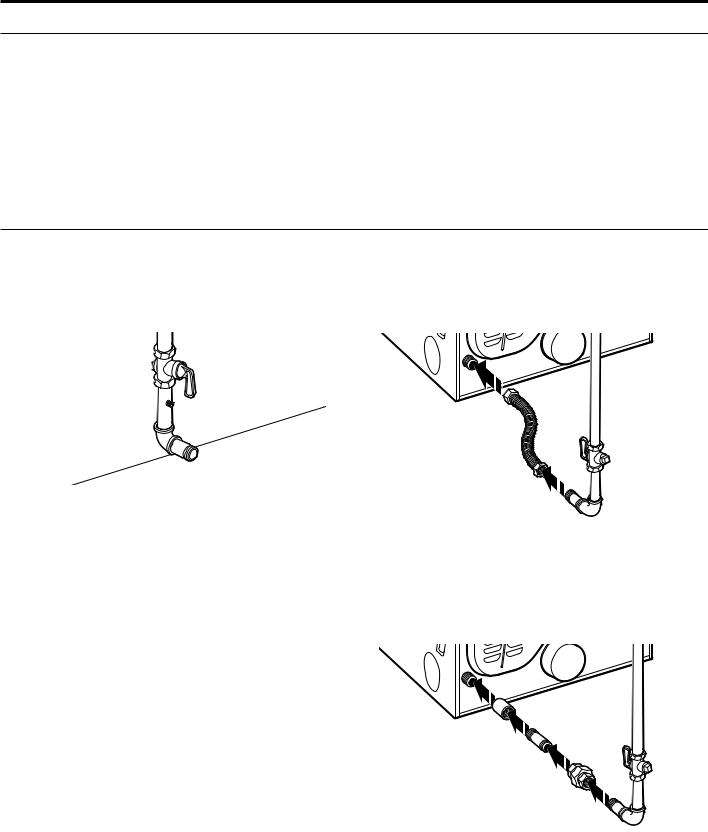
DRYER GAS SUPPLY REQUIREMENTS
Type of Gas
This dryer is equipped for use with natural gas. It is designcertified by CSA International for LP (propane and butane) gases with appropriate conversion. No attempt shall be made to convert dryer from gas specified on serial/rating plate for use with a different gas without consulting the serving gas supplier. Conversion must be done by a qualified service technician.
Gas conversion kit part numbers are listed on gas valve burner base.
Gas Supply Line
Recommended Method Flexible Metal Appliance Connector
Provide a gas supply line of 1⁄2" (13 mm) rigid (IPS) pipe to dryer location. Pipe joint compounds that resist action of LP gas must be used. Do not use TEFLON®† tape. With LP gas, piping or tubing size can be 1⁄2" (13 mm) minimum. Usually, LP gas suppliers determine size and materials used in the system.
Gas Supply Pressure Testing
A 1/8" (3 mm) NPT minimum plugged tapping, accessible for gauge testing, must be installed immediately downstream of the installed shut-off valve to the dryer (as shown above). The dryer must be disconnected from the gas supply piping system during any pressure testing of the system at test pressures in excess of 1/2" psig (352 kg/m2).
It is recommended that a new flexible stainless steel gas line, design-certified by CSA International, be used for connecting the dryer to the gas supply line. (The gas pipe which extends through the lower rear of the dryer is provided with 3⁄8"
(10 mm) male pipe thread.)
NOTE: Do not kink or damage the flexible stainless steel gas line when moving the door.
Rigid Pipe Connection
The rigid pipe connection requires a combination of pipe fittings
Alternate Method
The gas supply may also be connected using 3⁄8" (10 mm) approved copper or aluminum tubing. If the total length of the supply line is more than 20 ft. (6.1 m), larger tubing will be required.
If using natural gas, do not use copper tubing. Pipe joint compounds that resist action of type of gas supplied must be used.
Shut-off valve required
The supply line must be equipped with a manual shut-off valve installed within 6 ft. (1.8 m) of dryer in accordance
with National Fuel Gas Code, ANSI Z223.1. This valve should be located in same room as dryer. It should be in a location that allows ease of opening and closing. Do not block access to shut-off valve. In Canada, an individual manual shut-off valve must be installed in accordance with the B149 installation
codes CAN/CGA B149.1 and CAN/CGA B149.2.
to obtain an in-line connection to dryer.
†®TEFLON is a registered trademark of E.I. Du Pont De Nemours and Company.
18
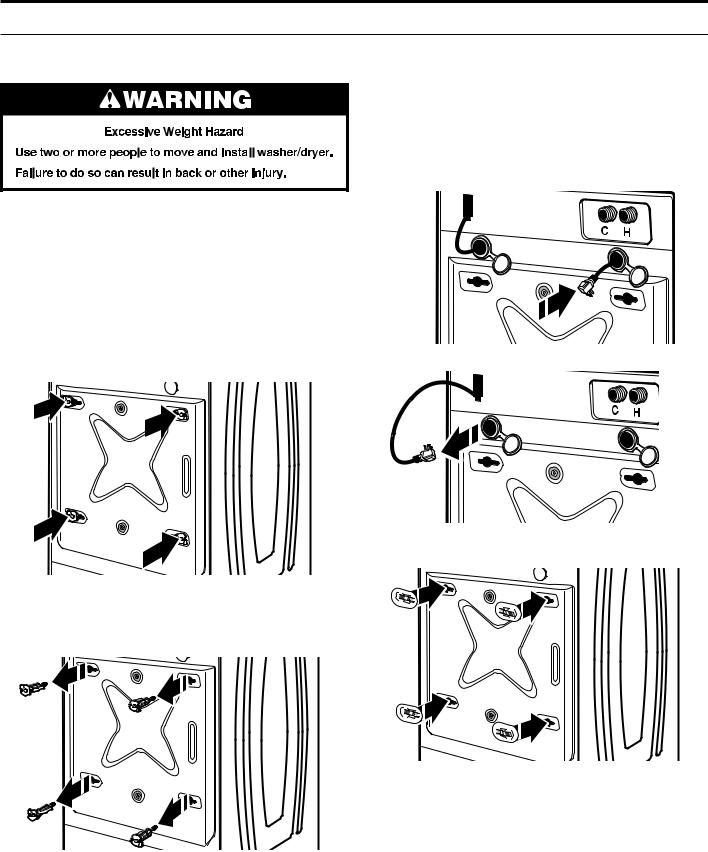
INSTALLING STACKED WASHER/DRYER
Remove Transport System
NOTE: Slide washer/dryer onto cardboard or hardboard before moving to avoid damaging floor covering.
IMPORTANT: Position the washer/dryer so that the rear of the washer is within approximately 3 ft. (900 mm) of its final location.
There are 4 shipping bolts in the rear panel of the washer that support the suspension system during transportation. These bolts also retain the power cord inside the washer until the bolts are removed.
1.Keep the washer/dryer in the upright position while removing the shipping bolts.
2.Using a 1/2" (13 mm) wrench, loosen each of the bolts.
4.Models with separate washer power cords: Push the power cord plug into the opening on the right side of the rear panel and pull the power cord through the opening on the left side of the rear panel and close holes with the attached cap. Do not pull plug end of power cord through the right side hole.
NOTE: To avoid damage to internal washer parts or the power cord, if the cord does not pull out of the washer rear panel easily, do not force it. Remove the washer rear panel and guide the power cord around the obstruction and out the hole on the left side of the rear panel.
5. Close the bolt holes with the 4 transport bolt hole plugs.
3. Once the bolt is loose, move it to the center of the hole
and completely pull out the bolt, including the plastic spacer covering the bolt. Once all 4 bolts are removed, discard the
bolts and spacers.
IMPORTANT: If the washer/dryer is to be transported, call your product distributor or installer. To avoid suspension and structural damage, your washer/dryer must be properly set up for relocation by a trained professional.
19
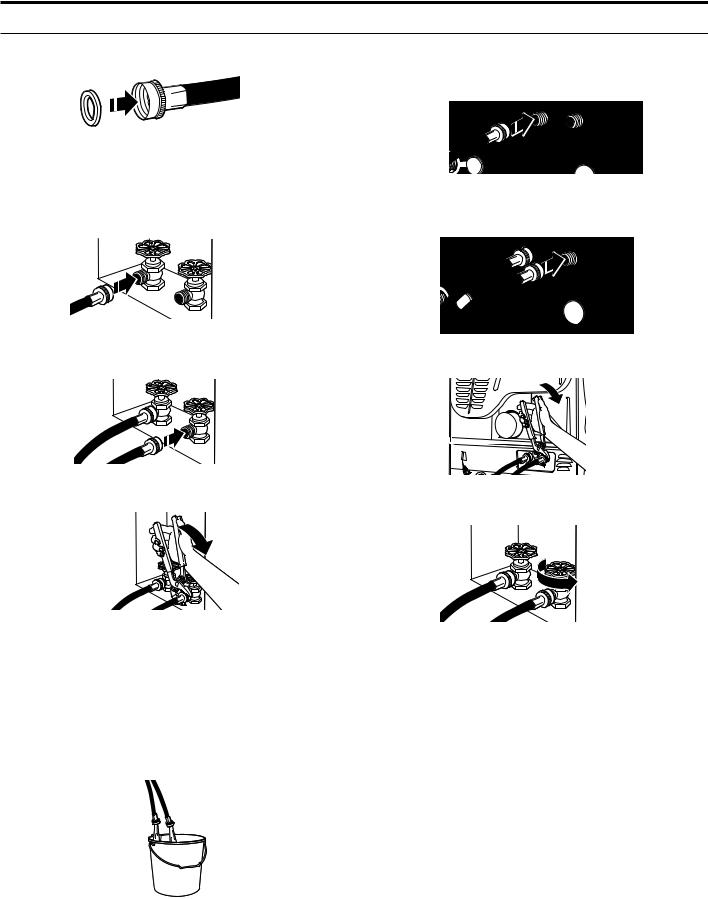
INSTALLING STACKED WASHER/DRYER
Connect Inlet Hoses
Insert new hose washers (supplied) into each end of the inlet hoses. Firmly seat the washers in the couplings.
washer coupling
Connect Inlet Hoses to Water Faucets
Make sure the washer drum is empty.
1.Attach a hose to the hot water faucet. Screw on coupling by hand until it is seated on the washer.
2.Attach a hose to the cold water faucet. Screw on coupling by hand until it is seated on the washer.
3.Using pliers, tighten the couplings with an additional two-thirds turn.
NOTE: Do not overtighten or use tape or sealants on the valve. Damage to the valves can result.
Clear Water Lines
νRun water through both faucets and inlet hoses, into a laundry tub, drainpipe, or bucket, to get rid of particles in the water lines that might clog the inlet valve screens.
νCheck the temperature of the water to make sure that the hot water hose is connected to the hot water faucet and that the cold water hose is connected to the cold water faucet.
Connect Inlet Hoses to Washer
1.Attach the cold water hose to the washer’s cold water inlet valve. Screw on coupling by hand until it is seated on the washer.
2.Attach the hot water hose to the washer’s hot water inlet valve. Screw on coupling by hand until it is seated on the washer.
3.Using pliers, tighten the couplings with an additional two-thirds turn.
NOTE: Do not overtighten. Damage to the valve can result.
4.Turn on the water faucets completely and check for leaks.
NOTE: Replace inlet hoses after 5 years of use to reduce the risk of hose failure. Record hose installation or replacement dates on the hoses for future reference.
Periodically inspect and replace hoses if bulges, kinks, cuts, wear, or leaks are found.
20
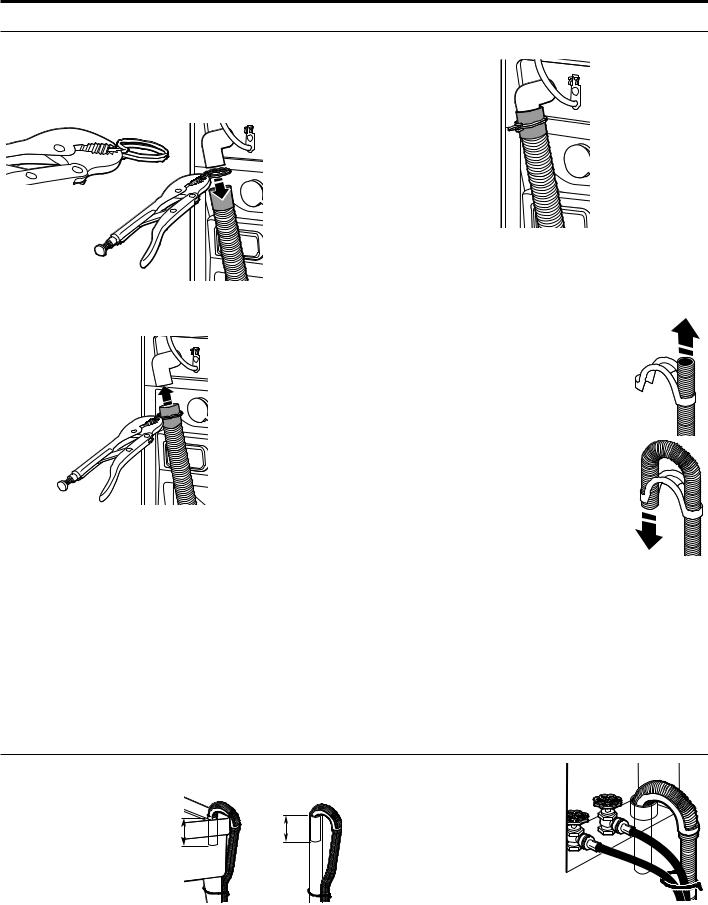
INSTALLING STACKED WASHER/DRYER
Route Drain Hose
Proper routing of the drain hose avoids damage to your floor due to water leakage. Read and follow these instructions.
Remove drain hose from the washer drum
1.Using locking pliers, squeeze hose clamp tabs together and insert over the end of the drain hose.
2. Slide the drain hose onto the washer connection.
3. Once the drain hose is in place, release the pliers.
4.The washer drain system can be installed using a floor drain, wall standpipe, floor standpipe, or laundry tub.
Laundry tub drain or standpipe drain
Connect the drain hose form to the corrugated drain hose.
Snap either end of the drain hose form to the drain hose at the point where the corrugation begins.
Bend drain hose over drain hose form and snap into place.
NOTE: Hose must not extend more than 1" (25 mm) past the end of the U bend.
To keep drain water from going back into the washer:
νDo not straighten the drain hose, do not force excess drain hose into standpipe. Hose should be secure, but loose enough to provide a gap for air.
νDo not lay excess hose on the bottom of the laundry tub.
Floor drain
You may need additional parts. See “Alternate Parts.”
Secure Drain Hose
1.Drape the power cord over the washer top.
2.Move the washer to its final location.
3.Place the drain hose
in the laundry tub or |
|
|
standpipe as shown. |
|
|
4. Secure the drain hose using |
41/2" |
41/2" |
the supplied beaded tie |
(114 mm) |
(114 mm) |
strap. |
|
|
|
|
5.If the washer faucets and the drain standpipe are recessed, put the hooked end of the drain hose
in the standpipe as shown.
NOTES:
ν Do not force excess drain hose back into the rear of the washer.
ν To avoid siphoning, do not seal the drain hose into the standpipe.
21

WASHER DRAIN SYSTEM
The washer can be installed using the standpipe drain system (floor or wall), the laundry tub drain system, or the floor drain system.
Standpipe drain system – wall or floor
The standpipe drain requires a minimum diameter standpipe of 2" (50 mm). The minimum carry-away capacity can be no less
than 10 gal. (38 L) per minute.
Wall
Laundry tub drain system
The laundry tub needs a minimum 20 gal. (76 L) capacity. The top of the laundry tub must be at least 30" (762 mm) above the floor.
30" (762 mm)
The top of the standpipe must be at least 30" (762 mm) high and no higher than 96" (2.4 m) from the bottom of the washer.
Floor
30" min. (762 mm)
Floor drain system
The floor drain system requires a siphon break that may be purchased separately.
The siphon break (Part Number 285834) must be a minimum of 28" (710 mm) from the bottom of the washer. Additional hoses might be needed.
Syphonbreak
28" (710 mm)
22
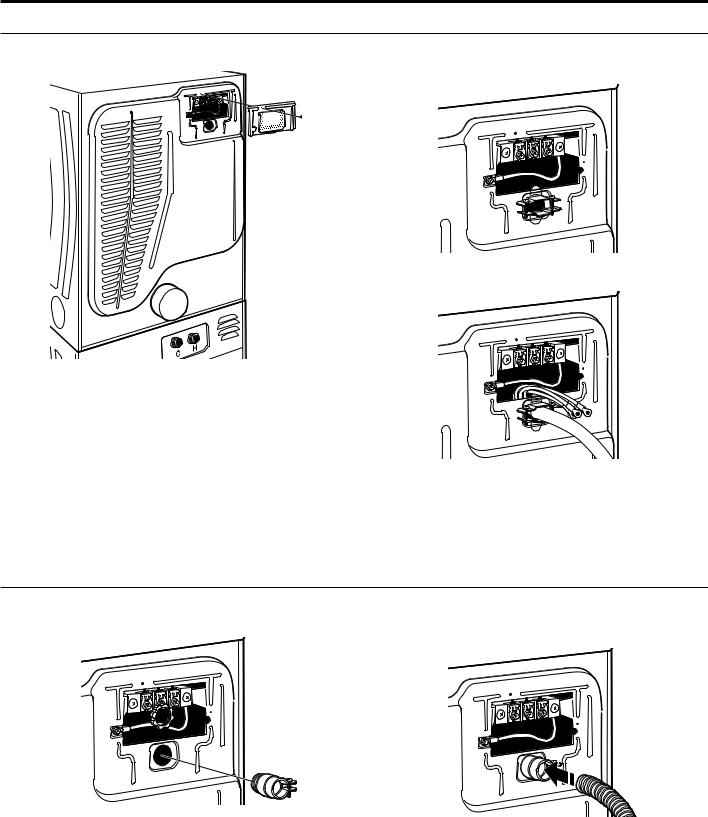
ELECTRIC DRYER ELECTRICAL CONNECTIONS
Strain Relief
Remove Terminal Block Cover |
Power Supply Cord Strain Relief |
1. Insert strain relief.
2. Insert power cord into strain relief.
Strain Relief
Direct Wire Strain Relief
1. Insert strain relief. |
2. Insert conduit into strain relief and tighten clamp. |
23
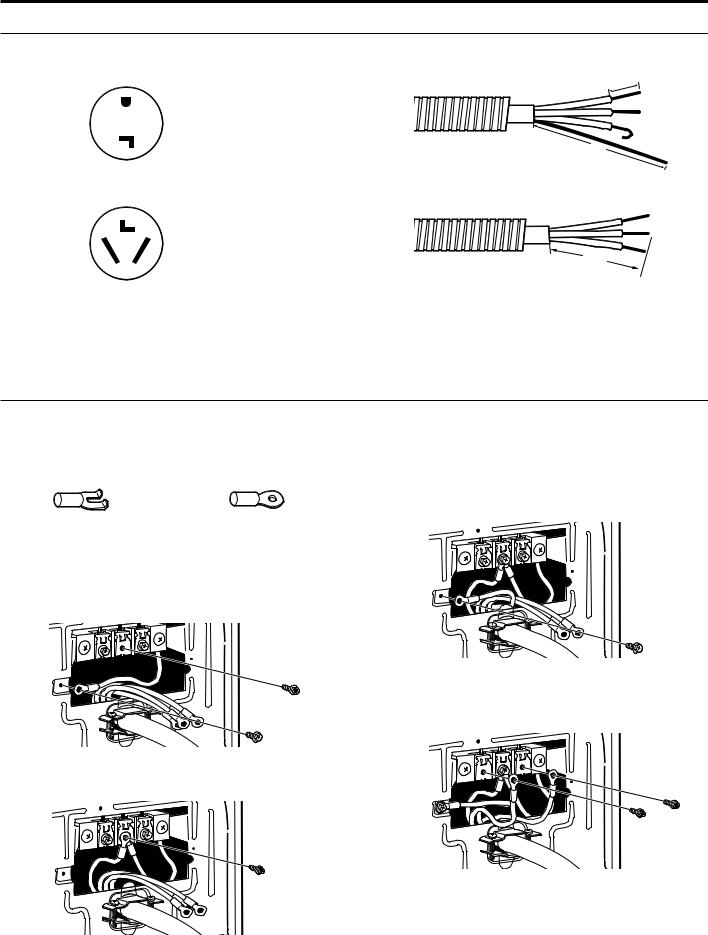
ELECTRIC DRYER ELECTRICAL CONNECTIONS
Connection Options
Power Cord |
Direct Wire |
4-wire receptacle (NEMA Type 14-30R) |
4-wire direct |
|
|
|
|
|
|
3-wire receptacle (NEMA Type 10-30R) |
3-wire direct |
||||
1" |
|
(25 |
mm) |
|
|
(127 |
5" |
|
mm) |
||
|
(89 |
3" |
|
mm) |
||
|
Connecting 4-Wire Connection: Power Supply Cord
IMPORTANT: A 4-wire connection is required where local codes do not permit the use of 3-wire connections.
Standard Power Supply Cord Connectors
Flanged spade connector |
Ring Connector |
Connecting Ground and Neutral Wires
1.Remove center terminal block screw and the ground wire by removing the external ground connector screw.
Connecting Direct Wire Ground
3.Connect ground wire (green or bare) with external ground connector screw.
Connecting Remaining Wires
4. Connect remaining wires with outer terminal block screws.
2. Connect ground and neutral wire to center terminal block.
24
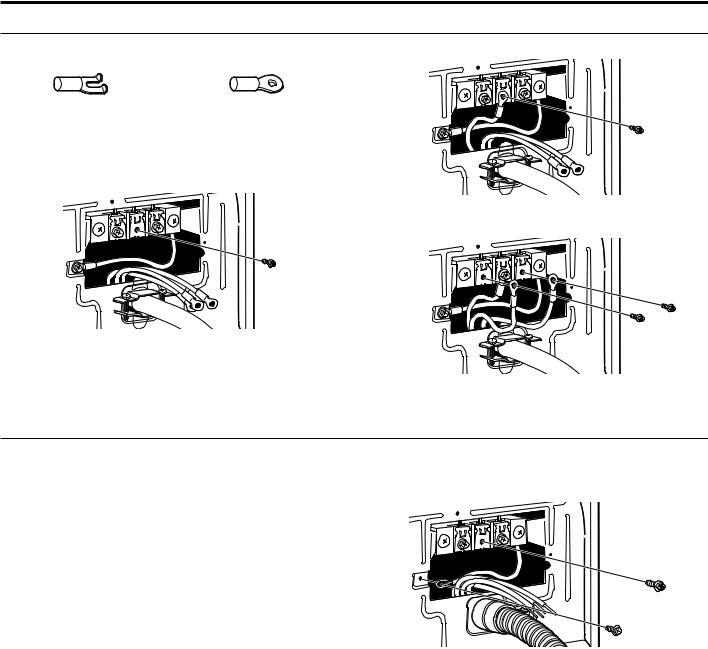
ELECTRIC DRYER ELECTRICAL CONNECTIONS
Connecting 3-Wire Connection: Power Supply Cord
Standard Power Cord Connectors |
2. Connect neutral wire to center terminal block. |
Flanged spade connector |
Ring Connector |
Connecting Neutral Wire
1. Loosen or remove center terminal block screw.
3. Connect remaining wires with outer terminal block screws.
Connecting 4-Wire Connection: Direct Wire |
|
IMPORTANT: A 4-wire connection is required where local |
Connecting Ground and Neutral Wires |
codes do not permit the use of 3-wire connections. |
|
1. Remove center terminal block screw and the ground wire Direct wire cable must have 5 ft. (1.52 m) of extra length so by removing the external ground connector screw.
dryer can be moved if needed.
Strip 5" (127 mm) of outer covering from end of cable,
leaving bare ground wire at 5" (127 mm). Cut 11⁄2" (38 mm) from 3 remaining wires. Strip insulation back 1" (25 mm). Shape ends of wires into a hook shape.
25
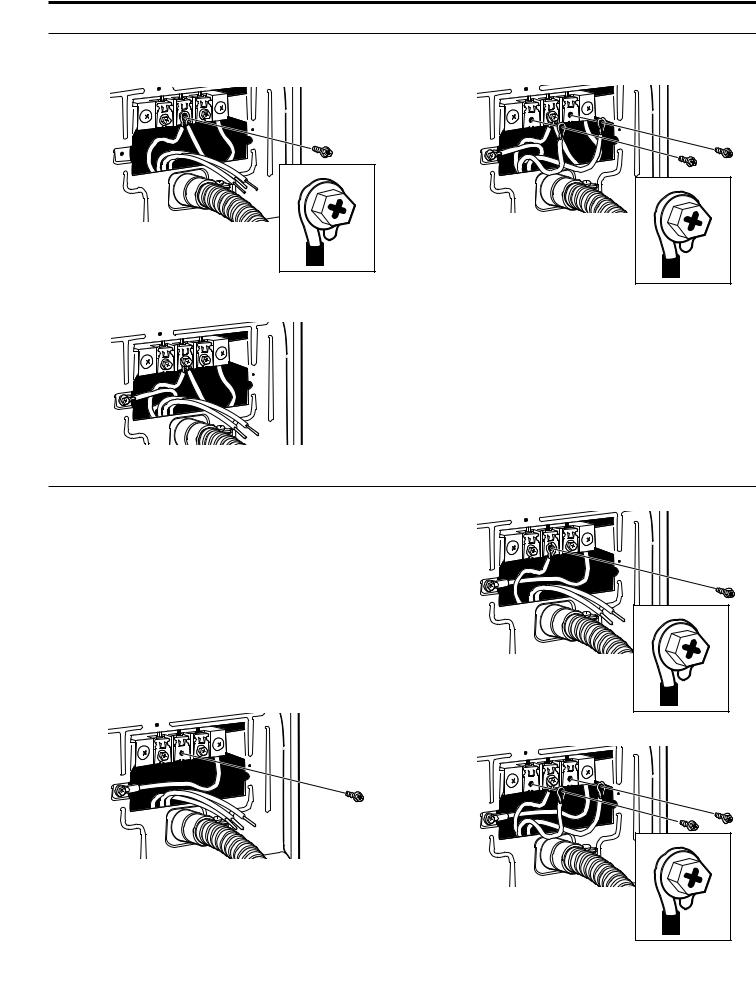
ELECTRIC DRYER ELECTRICAL CONNECTIONS
Connecting 4-Wire Connection: Direct Wire
Connecting Ground and Neutral Wires (cont.) |
Connecting Remaining Wires |
2. Connect ground and neutral wire to center terminal block. |
4. Connect remaining wires to outer terminal block. |
Connecting Direct Wire Ground
3.Connect ground wire (green or bare) with external ground connector screw.
Connecting 3-Wire Connection: Direct Wire |
|
Use where local codes permit connecting |
2. Connect neutral wire to center terminal block. |
cabinet-ground conductor to neutral wire. |
|
Direct wire cable must have 5 ft. (1.52 m) of extra length so dryer can be moved if needed.
Strip 31⁄2" (89 mm) of outer covering from end of cable. Strip insulation back 1" (25 mm). If using 3-wire cable with ground wire, cut bare wire even with outer covering. Shape ends of wires into a hook shape.
Connecting Neutral Wire
1. Loosen or remove center terminal block screw.
3. Connect remaining wires to outer terminal block.
26

ELECTRIC DRYER ELECTRICAL CONNECTIONS
Connecting 3-Wire Connection: Optional
Use for direct wire or power supply cord where local codes do not permit connecting cabinet-ground conductor to neutral wire.
Connecting Neutral Wire
1. Remove center terminal block screw. Also remove neutral |
3. Connect remaining wires to outer terminal block. |
|
ground wire by removing external ground conductor screw. |
||
|
2. Connect neutral wire and neutral wire of power supply cord/ |
4. Connect a separate copper ground wire from the external |
ground conductor to an adequate ground. |
|
cable to center terminal block. |
|
LEVELING
Leveling Stacked Washer/Dryer
Leveling your washer/dryer properly reduces excess noise and v bration.
Not Level |
LEVEL |
Not Level |
1.Remove cardboard from beneath washer/dryer. Place a level on top edges of washer/dryer, checking each side and front. If not level, tip washer/dryer and adjust feet up or down as shown in Steps 3 and 4, repeating as necessary.
27
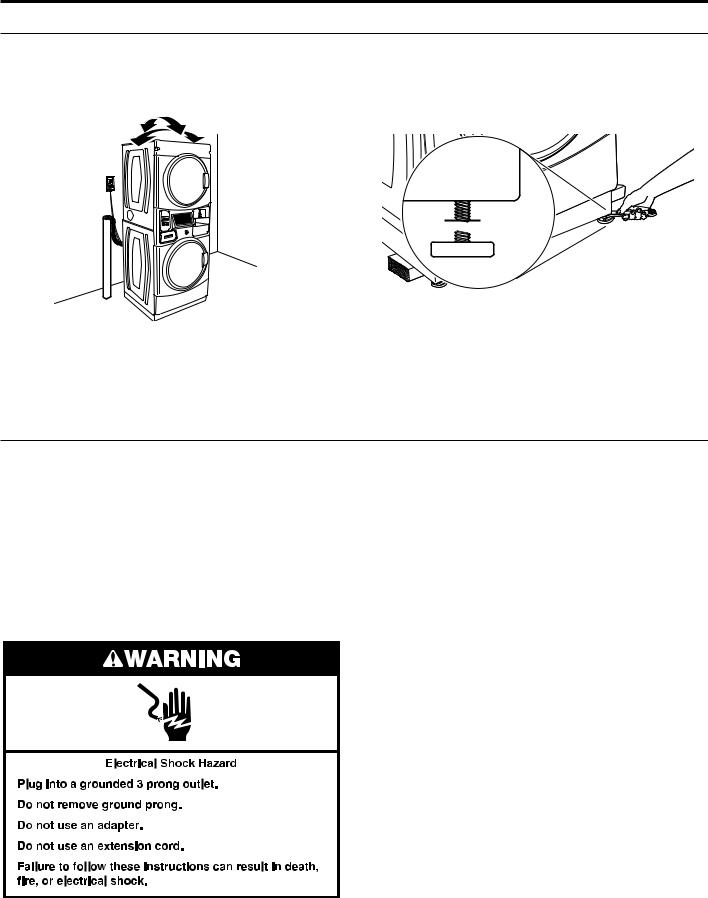
LEVELING
Leveling Stacked Washer/Dryer (cont.)
2.Grip washer/dryer from top and rock back and forth, making sure all four feet are firmly on floor. Repeat, rocking washer/dryer from side to side. If washer/dryer rocks, go to Step 3 and adjust leveling feet. If all four feet are in firm contact with floor, go to Step 4.
to raise the washer/dryer. Recheck levelness of washer/dryer and that all four feet are firmly in contact with the floor. Repeat as needed.
HELPFUL TIP: You may want to prop up front of washer/ dryer about 4" (102 mm) with a wood block or similar object that will support weight of washer/dryer.
3.If washer/dryer is not level, use a 9/16" or 14 mm openend or adjustable wrench to turn jam nuts clockwise (as viewed from above) on feet until they are about 1/2" (13 mm)
from the washer/dryer cabinet. Then turn the leveling foot counterclockwise to lower the washer/dryer or clockwise


 Jam nut
Jam nut
4.When washer/dryer is level and all four feet are firmly
in contact with the floor, use a 9/16" or 14 mm open-end or adjustable wrench to turn jam nuts counterclockwise (as viewed from above) on leveling feet tightly against washer/dryer cabinet.
HELPFUL TIP: You may want to prop washer/dryer with wooden block.
Complete Installation
1.Check the electrical requirements. Be sure that you have the correct electrical supply and the recommended grounding method. See “Electrical Requirements.”
2.Check that all parts are now installed. If there is an extra part, go back through the steps.
3.Check that you have all of your tools.
4.Dispose of/recycle all packaging materials.
5.Check that the water faucets are on.
6.Check for leaks around faucets and inlet hoses.
8.To test and to clean your washer, measure 1/2 the detergent manufacturer’s recommended amount of High Efficiency (HE) detergent for a medium-size load. Pour the detergent into the detergent dispenser. Select any cycle and allow the washer to complete one whole cycle.
9.Check dryer operation. Using a full heat cycle, let the dryer run for at least five minutes. Dryer will stop when time is used up.
NOTE: Dryer door must be closed for dryer to operate. When door is open, dryer stops, but timer continues to run. To restart dryer, close door and push cycle button.
If the burner does not ignite and you can feel no heat inside the dryer, shut off dryer for five minutes. Check that all supply valve controls are in “ON” position and that the electrical cord is plugged in. Repeat five-minute test.
7. Plug into a grounded outlet, or connect power.
28
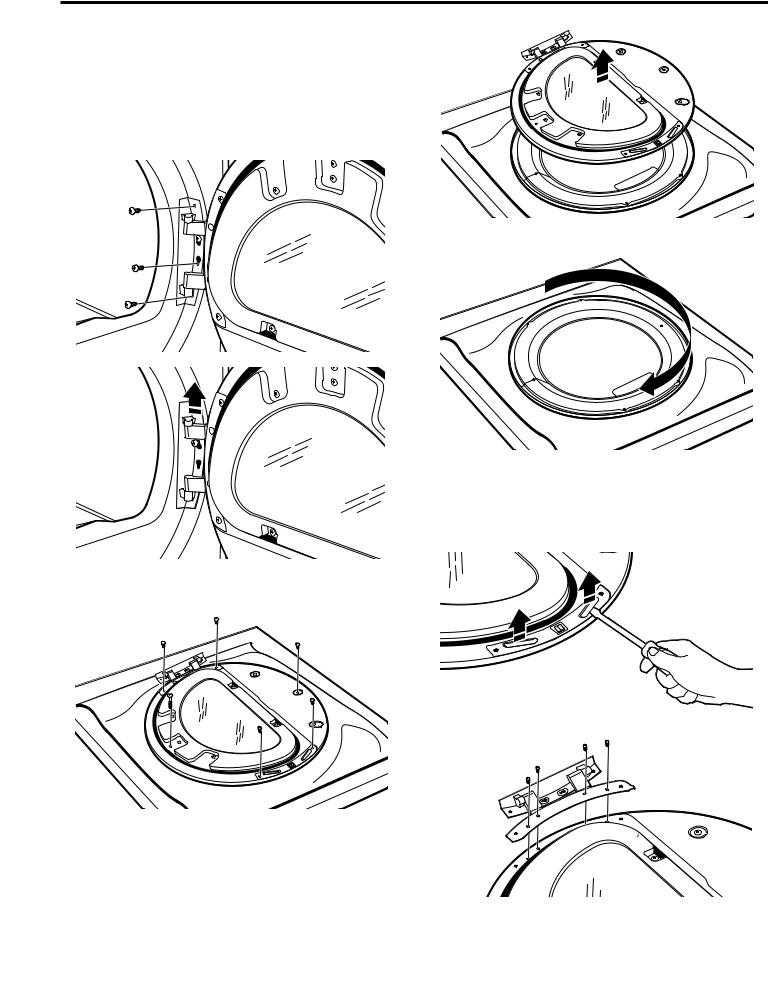
REVERSING DRYER DOOR SWING
NOTE: Dryer only. Washer door is not reversible.
Remove the Door Assembly
1.Place a towel or soft cloth on top of dryer or work space to avoid scratching of the surface.
2.Remove 3 of the 4 screws that hold the door hinge on the front panel of the dryer. Partially loosen the remaining screw with keyhole opening and lift the door off the screw.
3.Lay the door assembly on a previously prepared flat surface with the inside (inner door assembly) facing up, and remove 6 phillips-head screws to release outer door assembly from inner door assembly.
NOTE: It is important that you remove only 6 indicated screws.
4. Lift the inner door assembly off outer door assembly.
5. Rotate outer door 180°.
Reverse Hinge
1.Use a small flat-blade screwdriver to remove 2 plug strips from the inner door. Slide the head of the screwdriver under the plugs, without scratching inner door surface, and lift up strip.
2. Remove the 4 screws that attach to inner door hinge.
29
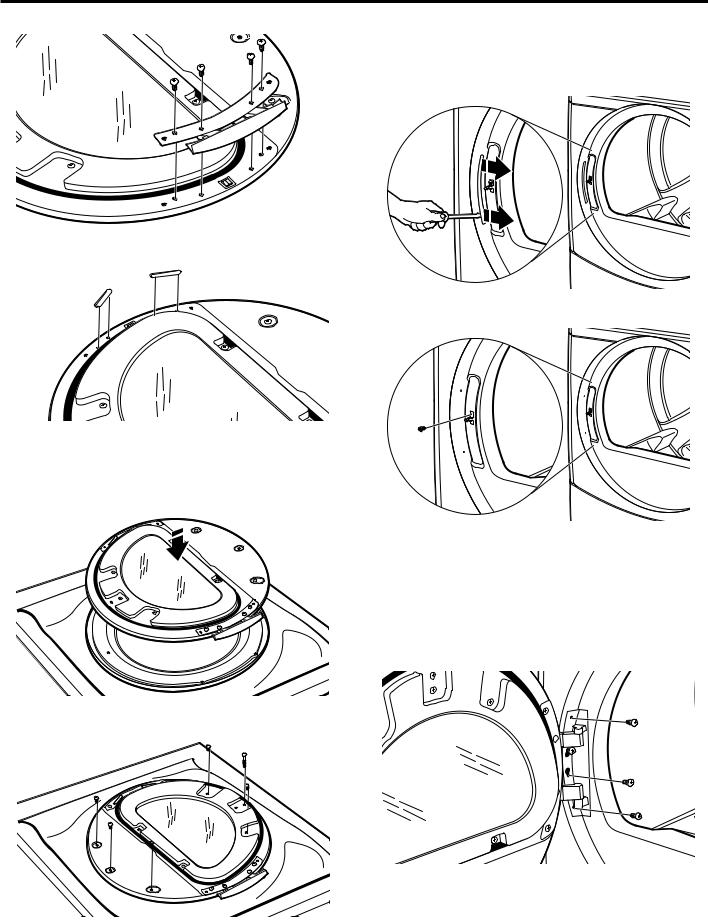
REVERSING DRYER DOOR SWING
3. Move hinge to other side. Reinstall 4 screws.
4. Reinstall plug strips on opposite side of the inner door.
5. Check for fingerprints on the glass. Clean if necessary.
Replace the Door Assembly
1.Place the inner door assembly inside the outer door assembly.
Reverse the strike
1.Use a small flat-blade screwdriver to remove plug strip from the dryer door opening. Slide the head of the screwdriver under the plugs, without scratching dryer surface, and lift up strip.
2. Remove the strike using a Phillips screwdriver.
3. Insert strike on the opposite side.
Reinstall the door
1.Partially insert the third screw from the top; then slide the hinge onto this screw while hooking the hinge into the front panel hole. Reattach door to dryer front panel with the remaining three screws.
2. Reassemble the inner and outer door assemblies with the 6 screws.
2. Check for fingerprints on the glass. Clean if necessary.
3. Close door and check that it latches securely.
30
